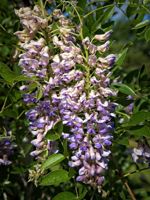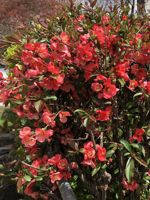Mon-Fri 9am - 5pm Mountain time
Blue Moon Wisteria vs Japanese Quince
Wisteria macrostachya Blue Moon
Chaenomeles japonica
NOT AVAILABLE THIS SEASON - MIGHT RETURN
Blue Moon Wisteria is a striking, flowering vine, and the hardiest of the wisterias. Up to three times in one growing season you can expect showy, fragrant, lavender-blue flowers.
Make sure you plan your site as this vine requires a structure to support its mature weight. Try planting close to a post, trellis, or fence.
Japanese Quince has bright, orange to red showy flowers that bloom in early spring. The flowers appear before the leaves and may continue to bloom after leaves emerge. Flowers grow on old wood, so pruning after flowering will help to promote new growth next spring. They produce yellow-green fruit that taste bitter when eaten raw, typically they are better suited for making preserves.
It can be used as a stand alone ornamental shrub, as a low hedge, or can be trained to grow against a wall. In late winter, branches of Japanese Quince can be cut and brought indoors where they will bloom on their own. They are deer and rabbit tolerant. The branches are spiny making them well suited for keeping unwanted wildlife away.
Blue Moon Wisteria Quick Facts
Japanese Quince Quick Facts
Toxicity: can be toxic to cats, dogs, and horses when consumed

